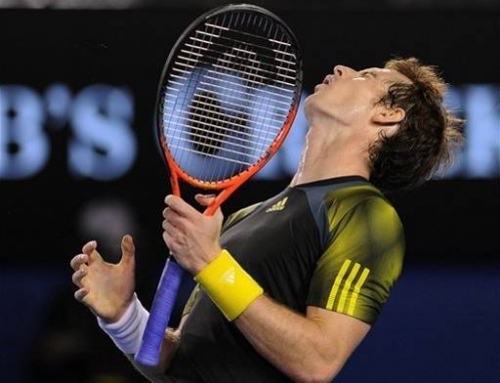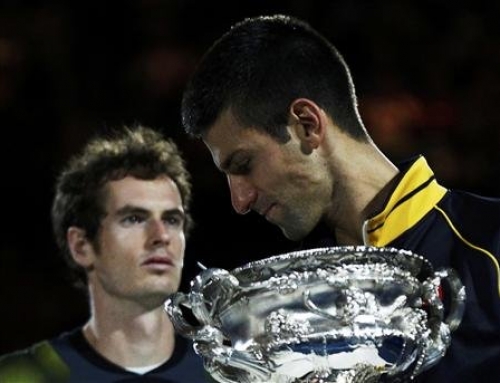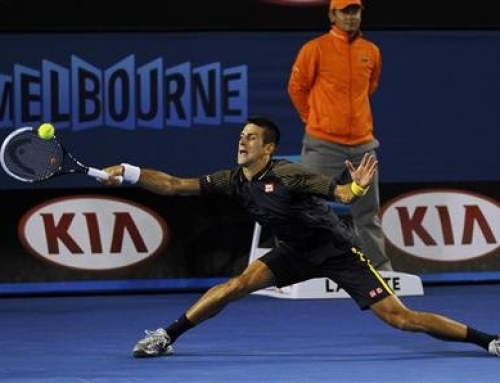 Everyone knew that Igor Andreev was a tough opponent. Two years ago, the wily Russian with the big forehand and the big serve gave players like Rafael Nadal trouble. In his 2008 US Open run, Roger Federer needed five sets to beat Andreev. Since then, Andreev’s rank has dropped some, though he remains in the top 50, and he has lost numerous first round matches, and didn’t look to pose a problem for Federer who had said he had had great practices and was playing as well as ever.
Everyone knew that Igor Andreev was a tough opponent. Two years ago, the wily Russian with the big forehand and the big serve gave players like Rafael Nadal trouble. In his 2008 US Open run, Roger Federer needed five sets to beat Andreev. Since then, Andreev’s rank has dropped some, though he remains in the top 50, and he has lost numerous first round matches, and didn’t look to pose a problem for Federer who had said he had had great practices and was playing as well as ever.
Except that when it came to the match, Federer didn’t look particularly different. Back when Federer was dominating, around 2005 or 2006, it seemed every player had trouble dealing with the variety of shot and the power of Federer’s game. However, the men’s field is not a static one, and players learn they need big shots to play against the big players.
Andreev has a big forehand and a big enough serve. He runs around his backhand nearly as much as Federer and can hit inside out or down the line. The problem is, much like Federer, Andreev can miss wildly. When he’s on, he’s tough to handle. When he’s off, you have a chance.
Ever since Federer started slipping a little in 2008, folks have wondered whether his game would take a leap up or not. Fed goes through phases where he shanks his forehand and makes inexplicable errors. Nowhere was this more evident than in the 2009 Australian Open final. Having played a brilliant set where he was on the verge of being broken, Federer played an early game in the fifth set, a game he was up 30-0, by making a series of unforced errors, and lost the game. He would get broken a second time to bring an anti-climatic ending to what had been a pretty compelling final.
Federer tried something a little different in the match against Andreev. Federer was spinning both sides a bit more, giving his shots more lift, presumably to address the shanking issue, and while he may not have shanked, he was also not as accurate, at times.
Perhaps the most worrisome aspect was the third set where Federer was serving for the third set to give him a 2 sets to 1 lead, and got broken twice, and had to break Andreev just to force a tiebreak. Federer seems to go through 1 or 2 such matches every Slam where he has to struggle. Obviously, the last time he played Andreev, or the five setter against Berdych (also at the AO), or the Haas match, or del Potro.
Normally Federer is used to dictating play, and he does this well enough against players like Murray, Djokovic, Nadal, and such. But against lower ranked players that use their power as the wildcard, Federer can struggle some.
Even so, this struggling is nothing new to Federer. Federer had early breaks in each set, was serving for the third set, and once he won the third set, his confidence rose, Andreev’s faltered, and he ran away with the fourth set.
The late match pitted two players that have seen better days. Richard Gasquet was once the wunderkind of France, picked to be the leading man even before he was a teen. Then, he was accused of having cocaine in his system. His excuse? He kissed a dancer that had been doing the illegal substance and it got into his system. It makes Andre’s crystal meth excuse look like poetry. Even so, Gasquet was allowed to return to tour, and even reached the final against Baghdatis in Sydney last week.
Mikhail Youzhny had a pretty great post US Open in 2009, winning Moscow and reaching the final of Tokyo and Valencia. Youzhny is known as something of an intense guy with a crew cut, one handed backhand, and an occasional habit of hitting himself until he bleeds.
For a while, Gasquet seemed the sharper of the two and took the first two sets before Youzhny took the next two sets in tiebreaks. The fourth set saw Gasquet getting to match points, but he was unable to consolidate. At the end of the fourth set, Youzhny had been struggling with cramps in his quads. The new rules just put in effect deal with cramping. Players have been accused of using medical timeouts to disrupt an opponent’s rhythm. The abuse had gotten so far that the ITF felt it had to do something.
Now, medical attention is only permitted during breaks between games and only for the period of the break and only twice. If a player is cramping in the middle of the game, and need immediate attention, they have to forfeit the game to get to break.
Normally, this would be great for Gasquet, but Gasquet was also cramping. And when push came to shove, the more aggressive player, which was Youzhny won the fifth set. Gasquet was down an early break, then broke back, then was broken. Gasquet seemed unable to muster much power off the ground. He may be one of the few players whose forehand is less of a weapon than his backhand. In a day and age where the big forehand defines men’s tennis, Gasquet lacks a big forehand. His backhand is huge, but it’s harder to set up to hit a big backhand, and Gasquet, in any case, seemed hit the big ones. It was Youzhny who was making bigger shots off both sides.
Gasquet apparently went through this last year at the Australian Open losing a marathon five setter in the third round, 12-10, to Fernando Gonzalez. Gasquet has to be relatively pleased however. He did reach the Sydney final, and Youzhny is a tough opener. We’ll see how the rest of the year goes for both players.






![[Aussie Open Final] Can Andy Murray beat Novak Djokovic?](https://www.essentialtennis.com/wp-content/uploads/2013/01/20130126andy-500x383.jpg)
![[Day 13, Aussie Open] Bryan brothers win 13th Slam with Aussie doubles title, Kyrgios wins boys title](https://www.essentialtennis.com/wp-content/uploads/2013/01/20130125bryan-500x383.jpg)